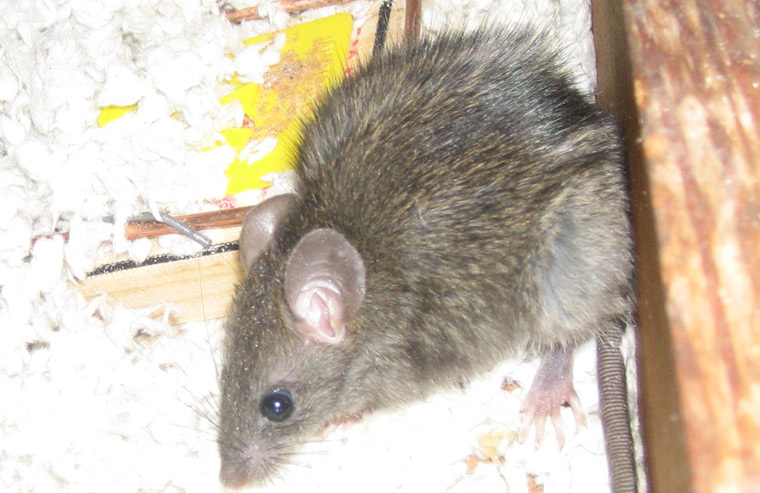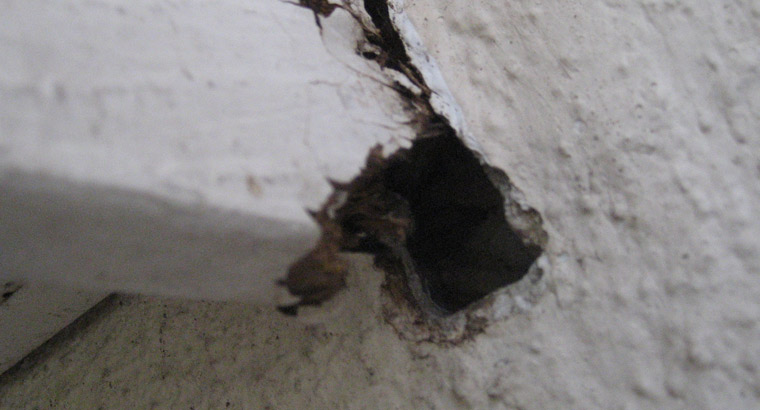-
info@aaanimalcontrol.com
Call us for help in your town
Humane Wildlife Education
Will Rats Chew Through Ceilings
Need rat removal in your hometown? We service over 500 USA locations! Click here to hire us in your town and check prices - updated for year 2020.
Rats will chew through almost any material, given
half the chance, and that's why it is important to
put a very serious plan into action when you
discover you have rats infesting your home or
commercial building.

Rats teeth can be scored on the Mohs scale, a
scale that measures how hard various material are.
The score goes from 1, being the softest material,
to 10, the hardest. Diamonds are well known to be
in highest scoring on the Mohs scale, with talc
being at the lower end of the scale.
For the record, the enamel on human teeth weighs
in at about 5 on the Mohs scale, and rats teeth
are harder still - 5.5. This means that their
teeth are actually harder than some metals,
including copper and iron.
Find out what to do if you hear a rodent on the roof.
Rats don’t just have super sharp teeth that
constantly grow and need to be filed down with
that chewing action, they have a very powerful jaw
too, and these two things work together to enable
the rodent to chew through most materials that it
would come up against. This includes many of the
common materials found in your home, and also
making up your home — cinder blocks, asbestos,
brick, plastic, wood, cement, aluminum and lead.
Find out whether or not rodents enter a building through the plumbing.
The ceiling provides almost no protection between
you and the rat, and it won’t be long before the
rat can chew right through it. It will do this if
it needs to escape, and this can often be the case
when animals have crawled into a deep space in
your home, and then been unable to get back out
again.
What is the Best Way to Repair a Hole a Rodent Chewed in Your House?
Need wildlife removal in your hometown? We service over 500 USA locations! Click here to hire us in your town and check prices- updated for year 2020.
Rodents are awful creatures, aren't they? They're tiny and flexible, which means they can crawl and squeeze into the tightest of spots. They spread diseases and parasites, and were even responsible for the spread of the Black Plague, and also the thousands of people that were wiped out by it. They're also the subject of horror stories, usually passed down through the generations. You can't tell me that you haven't heard of that one rat who once chewed a baby's face off, or the other one who attacked a human's throat in the night?

The good news is that rats won't generally attack humans, babies, children, or other animals unless they have been cornered, threatened or provoked. If you get the animal in a trap with no way out, there's a good chance it will try to bite you. That's the nature of wild animals, and also serves as a warning — wild animals are just that — wild — for a reason.
If you have spotted rodent holes, you should keep a well-trained eye out for other evidence, including feces, gnawed cereal boxes (and other food packaging), and even dead rodents. If you have a cat, it is likely that they will come in contact with each other at least once, and larger rats will defend themselves as best they can, but smaller ones, and mice too, will often come off worse.
The best way to repair a hole a rodent chewed in your house is by first inspecting the rest of your house, and then coming back armed with wire wool, expanding foam, thick, rubber gloves, and some more rodent traps, just in case. You should already have set a number of these rodent traps already, making sure you choose specifically built rat traps for rats, and mouse traps for mice. The rat traps are too large to capture mice effectively, and the smaller mouse traps could have very little effectiveness on capturing the bigger rats too. In fact, when you get the wrong trap, all you end up doing is maiming the creature, which then goes on to die somewhere in your home.
Nice, right?
Only when you are sure that your traps aren't catching any more rodents can you then go ahead to seal up any holes left behind. Ideally, you will want to have left one main hole open, sealed the remaining smaller holes, to then allow you to go back to the main hole once all rodents have been eradicated. The kind of hole you're dealing with, as well as the area within your home, will have a big part to play in what materials you use.
Wire wool and expanding foam is a good combination of material to use. The rats and mice can easily chew through the expanding foam, but the wire wool, if packed tightly enough, will form a protective barrier in the midst. The rats and mice can't chew through this metal layer with ease, so are therefore likely to turn around and leave … Or find another hole.
If you find yourself with multiple rodent holes in your building, we would definitely recommend seeking professional advice. A rat or mouse problem is one that can very easily get out of hand, very quickly, and you'll also find that many home insurance policies won't actually cover you if these rodents cause damage.
For more information, you may want to
click on one of these guides that I wrote:
How much
does rat removal cost? - get the lowdown on
prices.
How
to get rid of rats - my main rat removal
info guide.
Example
rat trapping photographs - get
do-it-yourself ideas.
Rat
job blog - learn from great examples of rat
jobs I've done.
rats in the attic
rats in the walls


















